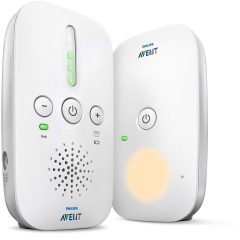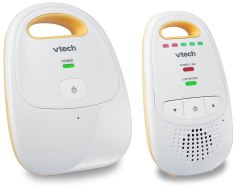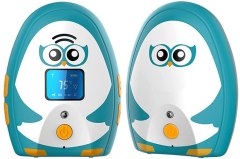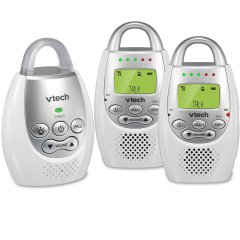BestReviews is reader-supported and may earn an affiliate commission. Details

A comprehensive sound-only baby monitor that guarantees a private connection.
Monitor and parent unit from a trusted brand. Has a range of 150 feet inside and 1,000 feet outside. Parent unit can be plugged in or battery-powered. Features power-saving mode and LED lights for sound level. Baby unit has a nightlight.
Battery power only lasts for 24 hours.

A baby monitor set with a rechargeable battery and belt clip.
Features a range of 1,000 feet and encrypted connection. Rechargeable battery lasts for 8 hours. Easy to set up units. Parent unit has volume control, LED lights for sound level, and alert sounds for low battery and poor connection.
May not be loud enough.

An audio-only set with a kid-friendly design and temperature monitoring.
Monitor designed as a penguin. Features a nightlight that can be operated from the parent unit. Has a loop for carrying and 2-way talk. Can play 8 lullabies. Parent unit includes volume control and a vibration alert function.
Temperature displayed may be slightly lower than the actual temperature.

This sound-only baby monitor has a good range and comes with 2 receivers.
Monitor set with 1 parent unit and 2 baby units. Secure connection. Has a range of 1,000 feet and LED lights for sound level. Features 2-way talk and a nightlight on the baby unit. Sound can be customized based on noise level.
This monitor sometimes has problems cutting out or failing to link.

A baby monitor and parent unit with 2-way talk and a backlit display.
Offers a private connection and range of 1,000 feet. Features temperature display and alerts and 2-way talk. Parent unit has a rechargeable battery. Screen shows the battery level. Slim profile and secure connection.
Does not have LED lights for sound level.

We recommend these products based on an intensive research process that's designed to cut through the noise and find the top products in this space. Guided by experts, we spend hours looking into the factors that matter, to bring you these selections.

Sound-only baby monitors are a reliable way to keep an ear on your nursery when you’re elsewhere in the house. Most units have highly sensitive microphones and speakers that relay your infant’s every coo, giggle, and cry.
In some limited cases, such as health problems or sensitive situations, a video monitor is a must. But for some people, they end up being more hassle than they’re worth. Video baby monitors have limited range, they freeze, they trigger false alarms, and they gobble up batteries. Plus, they tend to keep you glued to the screen at the very time you finally have a chance to unplug.
Most sound-only monitors, on the other hand, transmit sound using radio signals, so they’re much more reliable. They rarely glitch, they’re energy efficient, and many even let you respond to your baby’s cues.
We’ve scanned the market for the best sound-only baby monitors. Keep reading to learn more about what’s available. When you’re done, check our recommendations for the best sound-only monitors for your nursery.

Whether your nursery is right down the hall or down the stairs, you’ll need a monitor that can go the distance. Most sound-only monitors have a range between 100 feet and 1,000 feet. If you live in a two-story house, look at monitors on the higher end of the range. Even if your house is small, a longer-range monitor will let you keep an ear on your baby while you’re out doing yard work or playing with other children.
Every baby monitor on the market lets you hear sounds from your nursery, but some let you talk back, too. Look for models that support two-way communication if your baby is easily soothed with a gentle word or lullaby. This option may help you get a little more shut-eye.
Since most monitors use radio signals, it’s important to find one that can be used without interference. A good monitor gives you multiple channels, enabling you to switch if one frequency is in use. If you live in a rural area, a standard monitor with 5 channels should suffice. Densely populated areas are likely to have other baby monitors and radio equipment in use nearby, so if you live in an urban environment, look for monitors with more channels — some offer as many as 36!
When it comes to babies, safety is key! The best monitors transmit encrypted signals to your parent unit. That way, you can be sure that no one else is hearing you or your baby.
Virtually all base baby monitors plug into the wall; however, some also have options for cordless use. Many people who use monitors while camping or traveling love this option. If you want a monitor that can be cord-free, check whether you must charge it ahead of time or change out batteries during your trip.
Most parent units are designed to work either plugged into a wall outlet or with a battery, letting you hear your baby as you move from room to room. Again, if you want to take your parent unit on the go, find out whether it must be charged ahead of time or you’ll need to take spare batteries. If you think you’ll frequently use your monitor cord-free, consider whether a rechargeable unit or one using disposable batteries makes the most sense for you.
When your baby goes down for a nap, it’s likely time for you to take a shower. Or maybe older siblings want to splash in the pool. In these situations, and many others, a waterproof baby monitor is a good idea. It’s not unusual for a toddler (or a sleep-deprived parent) to knock a monitor off its perch. A drop-proof model can help make sure an accident doesn’t render the monitor unusable.

Most sound-only baby monitors come with a slew of features that can help simplify life for parents.
At first, you’ll probably want a constant stream of sound out of your little one’s room, but as time passes, you might decide that you don’t need to hear every toss, turn, and whimper. Many baby monitors have options for sound activation, which means they only transmit vocalizations or sounds that are loud enough to trigger the microphone. Consider this option if you’re a light sleeper.
Many sound-only baby monitors keep tabs on the room temperature as well as audio. Babies’ bodies are not able to regulate temperature the way adult bodies can. What’s more, they can’t tell you that they’re too warm or too cold. And a nursery that’s too hot increases a baby’s risk of sudden infant death syndrome (SIDS). A monitor with a thermometer lets you set a temperature range for the nursery and alerts you when the temperature dips below or rises above the acceptable range.
Night-lights are a must in any nursery, for both you and your child. They give the room a soft, calming glow for your baby and give you enough light to change a diaper or give baby a bottle. Some manufacturers combine these nursery staples into one convenient, multipurpose unit.
Forgetfulness, commonly called “baby brain,” is a side effect that lasts for many months after the birth of a baby thanks to frequent interruptions and sleepless nights. A monitor with a page button can help you easily locate a misplaced receiver by sending a loud alert to the parent unit, making it easier to find.
Sometimes you just need a few moments of peace and quiet. If you’re nervous about turning your sound-only monitor totally off, look for models that have indicator lights. These units feature displays that illuminate when they register a sound. Indicator lights often display muted, dimmer lights to register softer volumes and larger, brighter lights for more dramatic sounds, so you can tell visually whether your baby is simply chuckling or screaming.
Other features that may make your baby’s younger years easier include the following:
Low battery alert: This warns you when your receiver is about to run out of juice. Otherwise, you might mistake the silence for an extended naptime.
Vibration alert: Similar to those used for smartwatch alarms, this can help hearing-impaired parents know when their child is crying.
Music: Some monitors can play lullabies to soothe your little one at night.
Crib toys: The Baby Einstein Sea Dreams Soother keeps baby entertained as it gradually dims the light and lowers the volume to help your little one drift off to sleep.
Crib mattress: The soft and waterproof Serta Tranquility Crib Mattress helps keep your baby comfortable, so you can both get a good night’s sleep.
Crib sheets: Smooth, silky sheets help soothe your baby into slumber, and the Burt’s Bees Baby Fitted Crib Sheet is 100% organic cotton.
When it comes to value, even the highest-priced sound-only monitors are less expensive than the cheapest video baby monitors.
Inexpensive: You can find reliable sound-only baby monitors for under $30. At this price, most monitors have an indoor range of a few hundred feet. Some support two-way communication and include a night-light feature but don’t have a thermometer.
Mid-range: These sound-only monitors cost $30 to $40. In this price range, monitors have many bells and whistles like temperature monitoring, two-way communication, and night-lights. Some may come with two parent units, but most include one.
Expensive: The highest-quality sound-only baby monitors cost $40 to $60. Monitors with this price tag have all the features of lower-cost monitors, as well as extras like durable construction, prerecorded lullabies, or a second parent receiver.
Get two parent receivers. If you live in a larger home, look for a sound-only baby monitor that includes a second parent receiver. That way, you can keep one unit in a fixed, commonly used spot and take the other one on the go.
Change the channel. Don’t forget to change the channel on your parent units if you change it on your base unit.
Q. Do I really need a baby monitor?
A. Unless you live in a tiny dwelling and co-sleep at night, you probably do. Baby monitors are mostly used while your baby is in the crib to listen for crying or sounds of activity. At nap time, the monitor gives you the freedom to work in parts of the house or yard where you can’t hear the baby without it. At nighttime, the monitor wakes you up with auditory cues that your baby is making noise. If you co-sleep at night, a monitor might not be an issue, but you will still want to keep an ear on your baby at nap time. Unless you can hear your baby well from all parts of your house, a monitor is a good idea.
Q. Are sound-only baby monitors as good as video monitors?
A. Sound-only monitors won’t give you an image, but they are often more reliable than video monitors. Video baby monitors don’t always transmit well through walls or up stairs. Many run on WiFi, so if your WiFi is out, you have no monitor. Most people use monitors at night when they’re sleeping, so they rely on the audio to wake them up anyway. Sure, once you’re awake you’ll have to go check on the baby rather than look at the screen. Only you can decide whether that’s worth the price difference. Video baby monitors generally cost $20 to $100 more than sound-only monitors.
Q. What’s the difference between a standard monitor and a DECT monitor?
A. Most baby monitors operate on a 2.4 gigahertz (GHz) frequency, the same frequency as many other devices that you own, as well as devices in your neighbors’ homes. Those that feature DECT technology operate on a 1.9 GHz frequency. Since it doesn’t share the frequency with your cordless phone, garage door opener, or router, it gets much less static and interference.
Get emails you’ll love.
Learn about the products you’re wondering if you should buy and get advice on using your latest purchases.
